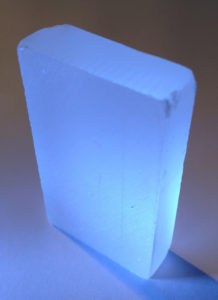Csl(Tl)
A rugged, non-hygroscopic alternative to NaI
CsI(Tl) has the advantage that it not really hygroscopic (its surface, however, is influenced by humidity over time).
It does not cleave or crack under stress.
It is a relatively bright scintillator but its emission is located above 500 nm where PMTs are not that sensitive. However, due to this property, it can effectively be read out by silicon photodiodes or
Thanks to its different decay times for charged particles having a different ionizing power, CsI(Tl) crystals are frequently used in arrays or matrices in particle physics research.
Properties
- Material – CsI(Tl)
- Density (g/cm3) – 4.51
- Emission Maximum (nm) – 550
- Lower wavelength cutoff [nm] – 320
- Thermal expansion coefficient (K-1) – 54 x 10-⁶
- Decay Constant – 0,6/3.4 µs
- Afterglow (after 6ms) [%] – 0.5 – 5.0
- Refractive index @ emission max 1.79
- Conversion Efficiency – 45
- Light yield (photons/KeVγ) – 41
- Hygroscopic – Slightly
- Photoelectron yield [% of NaI(Tl)] (for γ-rays) – 85
With its high light output, Caesium Iodides high resistance to radiation makes it ideal for use in nuclear and medium to high energy physics as well as radiation detection.



